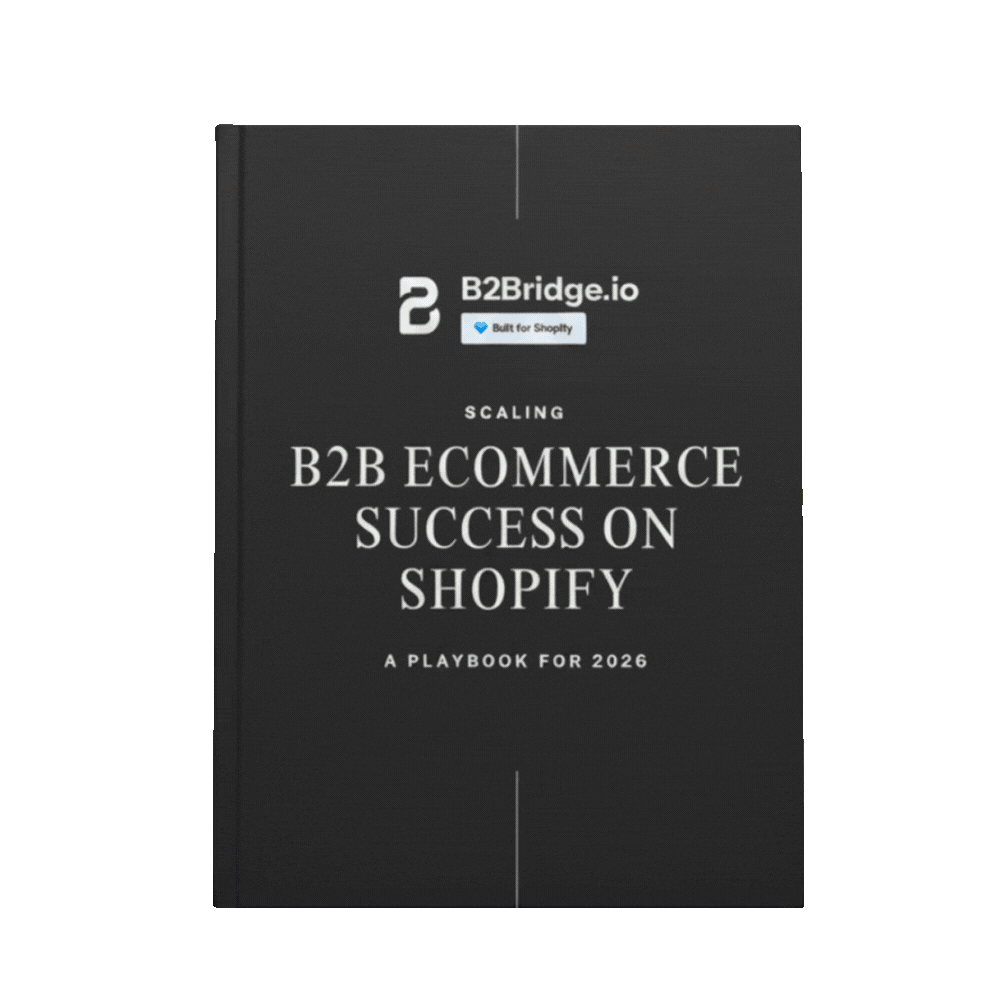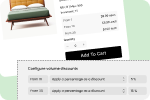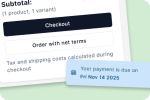Net 60 is a payment term commonly used in business transactions where the buyer has 60 calendar days from the invoice date to pay the full invoice amount in cash to the seller.
But what exactly does “Net 60” mean, and how can it impact your business’s cash flow and customer relationships? This comprehensive guide breaks down everything you need to know about Net 60 payment terms. You’ll learn:
- What are net 60 payment terms?
- How net 60 works
- Benefits and challenges of net 60
- Calculation methods with real examples of net 60
- Best practices for implementation net 60 payment terms.
Let’s dive into the details of Net 60 payment terms and how they can work for your business.
What Are Net 60 Payment Terms?
Net 60 payment terms are a type of trade credit arrangement where the buyer has 60 days from the invoice date to pay the full amount owed to the seller. The “net” indicates that the full invoice amount is due without deductions (unless early payment discounts apply), and “60” refers to the number of days allowed for payment.
In practice, if a vendor issues an invoice on January 1st with Net 60 terms, the payment is due by March 1st (or March 2nd in non-leap years). The 60-day period typically begins on the invoice date, though some businesses calculate from the delivery date or end of the month, so it’s crucial to clarify this in your contracts.

Who commonly uses Net 60 payment terms?
- Wholesalers and distributors serving retail businesses that need time to sell inventory before paying
- Manufacturers supplying to other businesses with longer production cycles
- Service providers working on projects with delayed payment schedules
- B2B companies building relationships with established, creditworthy customers
Variations with early payment discounts:
Net 60 terms often come with incentives for early payment. The most common variations include:
- 2/10 Net 60: Take a 2% discount if paid within 10 days, otherwise the full amount is due in 60 days
- 1/10 Net 60: Take a 1% discount if paid within 10 days, otherwise pay the full amount within 60 days
For example, imagine a wholesale supplier invoices a retailer $10,000 with 2/10 Net 60 terms on March 1st. If the retailer pays by March 11th, they only owe $9,800 (saving $200). If they pay anytime between March 12th and April 30th, they owe the full $10,000. This structure rewards buyers who can pay quickly while still offering flexibility for those who need the extended 60-day window.
Transform your B2B store with B2Bridge.
Discover how B2Bridge can transform your wholesale business.
Schedule a demo today to see our payment management tools in action.
Whether you’re a wholesaler considering offering Net 60 for the first time or an established business looking to optimize your payment term strategy, the principles remain the same: communicate clearly, automate where possible, assess credit carefully, and maintain strong customer relationships.
For Shopify merchants managing B2B sales, modern tools like B2Bridge eliminate the complexity of tracking payment terms, credit limits, and customer-specific pricing. Instead of juggling spreadsheets and manual processes, you can focus on what matters most – growing your wholesale business and serving your customers.

How Net 60 Payment Terms Work
Understanding the mechanics of Net 60 payment terms helps both buyers and sellers manage expectations and maintain healthy business relationships.
The billing and payment process:
- Credit approval: Before extending Net 60 terms, sellers typically evaluate the buyer’s creditworthiness through credit checks, references, and financial statements. Not all customers qualify – new or smaller businesses may need to start with shorter terms or prepayment.
- Invoice issuance: Once goods are delivered or services completed, the seller issues an invoice clearly stating “Net 60” or “Payment Due in 60 Days” along with the invoice date and due date.
- Payment period calculation: The 60-day clock starts ticking from the invoice date (most common) or sometimes from the delivery date or end of month. It’s essential to clarify whether these are calendar days (including weekends and holidays) or business days – typically, Net 60 means calendar days.
- Early payment discount window: If terms like 2/10 Net 60 apply, buyers have the first 10 days to take advantage of the discount. After day 10, they forfeit the discount but still have until day 60 to pay without penalty.
- Payment submission: Buyers submit payment via check, ACH transfer, wire transfer, or credit card (if accepted) before or on the due date.
Accounting implications:
For sellers, Net 60 creates accounts receivable that won’t convert to cash for two months. This impacts working capital and requires careful cash flow forecasting. The invoice is recorded as revenue immediately, but the cash hasn’t arrived yet.
For buyers, Net 60 creates accounts payable that they can strategically time to optimize their own cash flow. They receive inventory or services now but preserve cash for 60 days, improving liquidity for other operational needs.
Early payment discount considerations:
Taking a 2% discount for paying 50 days early (2/10 Net 60) represents an annualized return of approximately 14.69% – often better than the cost of capital. Savvy buyers frequently take advantage of these discounts when possible.
Ready to streamline your Net 60 payment term management? Discover how B2Bridge can transform your wholesale operations on Shopify.
Benefits of Net 60 Payment Terms
Net 60 payment terms offer significant advantages for both buyers and sellers when implemented strategically.
For Buyers:
- Improved cash flow management: Sixty days provides ample time to receive, process, and potentially resell goods before payment is due. Retailers can sell inventory and collect customer payments before paying their supplier.
- Better inventory planning: Extended terms allow businesses to stock up on inventory without immediate cash outlays, supporting seasonal planning and bulk purchasing strategies.
- Opportunity to verify quality: Buyers have time to inspect goods, test services, and identify any issues before payment is processed, reducing disputes and returns.
- Competitive advantage: Preserving cash longer enables investment in marketing, expansion, or other growth initiatives that drive competitive positioning.
For Sellers:
- Competitive differentiation: Offering Net 60 when competitors offer only Net 30 can win larger accounts and secure long-term contracts.
- Attract established customers: Larger, creditworthy companies often expect extended payment terms. Offering Net 60 opens doors to enterprise-level relationships.
- Build customer loyalty: Flexible, generous payment terms foster trust and strengthen supplier-customer partnerships, leading to repeat business and referrals.
- Higher order values: When cash flow isn’t an immediate constraint, buyers may place larger orders, increasing average transaction sizes.
- Enable B2B channel growth: Extended terms are often essential for scaling wholesale operations and competing effectively in B2B marketplaces.
Challenges and Risks of Net 60 Payment Terms
While Net 60 offers benefits, it also introduces challenges that businesses must carefully manage.
Cash flow strain on sellers:
Waiting 60 days for payment can create significant working capital challenges, especially for smaller businesses or those with tight margins. If you have suppliers to pay, employees to compensate, and overhead to cover, a two-month delay in receivables can stress your financial position. Sellers must ensure they have adequate cash reserves or credit lines to bridge the gap.
Late payment and default risks:
Not every customer pays on time. Late payments beyond 60 days are surprisingly common in B2B transactions – studies show that 62% of B2B invoices are paid late. Defaults, while less frequent, can devastate small businesses that extend significant credit. Even one major default can eliminate months of profit margins.

Increased administrative burden:
Managing Net 60 accounts requires robust systems for tracking invoice due dates, sending payment reminders, following up on late payments, and reconciling accounts. This administrative overhead increases costs and requires dedicated staff or software solutions.
Credit evaluation complexity:
Determining which customers qualify for Net 60 terms requires thorough credit checks, reference verification, and ongoing monitoring. New or unproven customers present greater risk, yet turning them away may cost sales opportunities. Finding the right balance demands careful judgment and clear credit policies.
Mitigation strategies sellers use:
- Invoice factoring: Selling receivables to a factoring company at a discount to receive immediate cash
- Credit insurance: Protecting against customer defaults through specialized insurance products
- Tiered payment terms: Offering Net 30 to new customers and Net 60 only after a track record is established
- Personal guarantees: Requiring business owners to personally guarantee payment for smaller companies
- Regular credit reviews: Monitoring customer financial health and adjusting terms as risk profiles change
What is the Difference between Net 30 and Net 60 Terms?
Here is a detailed comparison of Net 30 vs Net 60 payment terms:
| Feature | Net 30 Payment Terms | Net 60 Payment Terms |
| Definition | Payment due within 30 days from invoice | Payment due within 60 days from invoice |
| Common Usage | Most common for small businesses, B2B | Often used by larger companies, wholesalers |
| Payment Period | Shorter, encourages quicker payments | Longer period offers more payment flexibility |
| Cash Flow Impact (Buyer) | Requires quicker payment arrangement | Provides more time to manage cash flow |
| Cash Flow Impact (Seller) | Faster cash inflow, better liquidity | Delay in cash receipt may strain liquidity |
| Risk of Late Payment | Lower due to shorter timeframe | Higher risk due to extended payment window |
| Trade Credit Approval | Easier for new or small businesses | Often requires stronger credit or guarantees |
| Typical Industries | Services, retail, contracts | Wholesale, manufacturing, larger scale supply |
| Early Payment Discounts | Common (e.g., 2/10 Net 30) | Often offered to incentivize early payment |
| Administrative Burden | Moderate | Higher, due to longer monitoring requirements |
Comparing Net 60 to Other Common Payment Terms
Understanding how Net 60 stacks up against other payment terms helps businesses choose the right approach for their situation.
| Payment Terms | Payment Window | Best For | Pros | Cons |
| Net 15 | 15 days | High-margin products, new customers, perishable goods | Fast cash conversion, minimal credit risk | May lose competitive sales, limits buyer flexibility |
| Net 45 | 45 days | Mid-sized orders, established relationships | Good balance of flexibility and cash flow | Less common, may confuse some buyers |
| Net 60 | 60 days | Wholesale, large orders, enterprise customers | Competitive advantage, attracts major accounts | Significant cash flow impact, higher risk |
| Net 90 | 90 days | Government contracts, very large enterprises | Wins highest-value contracts | Severe cash flow strain, highest risk exposure |
Financial impact comparison:
A supplier doing $100,000 in monthly sales faces different working capital needs based on payment terms:
- Net 15: Approximately $50,000 in outstanding receivables
- Net 45: Approximately $150,000 in outstanding receivables
- Net 60: Approximately $200,000 in outstanding receivables
- Net 90: Approximately $300,000 in outstanding receivables
The longer the terms, the more capital tied up in receivables, requiring either larger cash reserves or access to credit facilities.
Industry Trends: Wholesale Pricing & Payment Terms
The wholesale industry has seen significant evolution in payment term practices over recent years, with Net 60 becoming increasingly standard for larger transactions.
According to recent B2B payment studies, the average payment term in wholesale has extended from approximately 45 days in 2018 to over 52 days in 2024. This trend reflects several market dynamics:
Buyer expectations are rising:
As Ecommerce giants like Amazon Business and Alibaba offer flexible payment options, traditional wholesalers face pressure to match or exceed these terms. Net 60 has become a baseline expectation rather than a premium offering for many enterprise buyers.
Digital transformation enables better credit management: Modern accounting software, automated credit checking, and AI-powered risk assessment tools make it easier for wholesalers to safely extend Net 60 terms to more customers. Technology has reduced the administrative burden that previously made long payment terms impractical.
Competitive differentiation through financing: Some progressive wholesalers are even exploring “buy now, pay later” style offerings that extend beyond traditional Net terms, effectively providing financing as a value-added service. This positions payment flexibility as a core part of the wholesale value proposition.
Impact on pricing strategies: Interestingly, wholesalers offering Net 60 often maintain slightly higher base prices than those requiring prepayment or Net 15 terms. The financing cost is essentially built into the pricing structure. However, the convenience and cash flow benefits for buyers often outweigh the marginally higher prices, making this a viable strategy.
The wholesale channel is also seeing increased adoption of dynamic payment terms, where credit limits and payment windows adjust based on customer payment history, order size, and seasonal factors. This flexible approach maximizes sales while managing risk more intelligently than one-size-fits-all terms.
How to Calculate Net 60 Payment Due Dates and Discounts
Understanding how to accurately calculate payment due dates and early payment discounts is essential for both buyers and sellers managing Net 60 terms.
Calculating the payment due date:
Step 1: Identify the invoice date (the starting point for the 60-day period)
Step 2: Add 60 calendar days to the invoice date
Step 3: Adjust for month-end variations (remember that months have different numbers of days)
Example calculation:
- Invoice date: January 15, 2025
- Add 60 days: March 16, 2025 (payment due date)
Example with month-end:
- Invoice date: January 31, 2025
- Add 60 days: April 1, 2025 (since February has only 28 days in 2025)
Calculating early payment discounts (2/10 Net 60):
Formula: Discount Amount = Invoice Total × Discount Percentage
Step 1: Calculate the discount deadline (invoice date + 10 days)
Step 2: Calculate the discount amount
Step 3: Subtract discount from invoice total to get payment amount
Example:
- Invoice total: $15,000
- Terms: 2/10 Net 60
- Invoice date: February 1, 2025
- Discount deadline: February 11, 2025
- Full payment due date: April 2, 2025
If paying by February 11:
- Discount amount: $15,000 × 0.02 = $300
- Payment amount: $15,000 – $300 = $14,700
If paying after February 11:
- Payment amount: $15,000 (no discount)
Why early payment discounts matter:
Taking a 2% discount to pay 50 days early (2/10 Net 60) is equivalent to an annualized interest rate of approximately 14.69%. This is calculated using the formula:
Annual Rate = (Discount % / (100% – Discount %)) × (365 / Days Accelerated)
For 2/10 Net 60: = (2 / 98) × (365 / 50) = 0.0204 × 7.3 = 14.9%
This often exceeds the cost of short-term business financing, making early payment discounts financially attractive when buyers have available cash or credit.
Best Practices for Managing Net 60 Payment Terms
Successfully implementing Net 60 payment terms requires thoughtful policies and consistent execution.
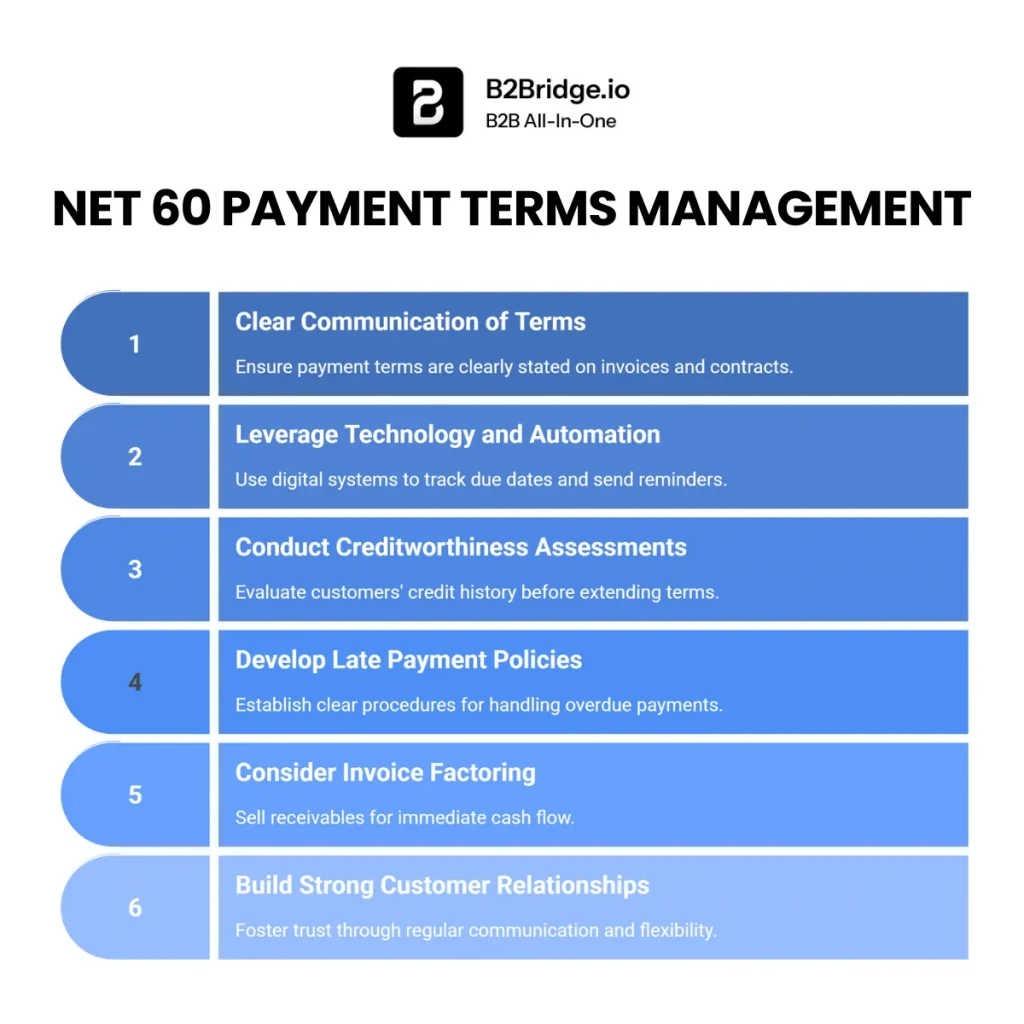
Clear communication of terms:
- State payment terms prominently on invoices, purchase orders, and contracts
- Specify the exact due date, not just “Net 60”
- Include early payment discount details if applicable
- Clarify whether days are calendar or business days
- Provide multiple payment methods and instructions
Leverage technology and automation:
- Use digital invoicing systems that automatically track due dates
- Set up automated email reminders at 30 days, 45 days, and 55 days before the due date
- Implement customer portals where buyers can view outstanding invoices and payment history
- Integrate accounting software (QuickBooks, Xero, NetSuite) with your order management system
- Consider B2B Ecommerce platforms like B2Bridge that handle Net terms natively within Shopify
Conduct thorough creditworthiness assessments:
- Run credit checks through Dun & Bradstreet, Experian, or Equifax before extending Net 60
- Request trade references from new customers’ other suppliers
- Start new customers on Net 30 or require deposits, then graduate to Net 60 after 3-6 months of on-time payments
- Set credit limits based on customer size, payment history, and financial stability
- Review credit status annually or when order patterns change significantly
Develop clear late payment policies:
- Specify late fees in writing (typically 1.5% per month or 18% annually)
- Send immediate follow-up when payment is one day late
- Escalate with phone calls and personal contact for payments 10+ days overdue
- Consider suspending future orders for accounts 30+ days past due
- Work with collection agencies or legal counsel for seriously delinquent accounts
Consider invoice factoring for cash flow:
- Sell receivables to factoring companies at 2-5% discount for immediate cash
- Use selective factoring for large invoices that would strain working capital
- Maintain confidentiality (non-notification factoring) to preserve customer relationships
- Compare factoring costs against early payment discounts you offer
Build strong customer relationships:
- Regular communication builds trust and reduces payment conflicts
- Understand your customers’ payment cycles and work with their schedules when possible
- Be flexible and work out payment plans for valued customers facing temporary difficulties
- Reward consistently on-time payers with higher credit limits or better terms
FAQ About Net 60 Payment Terms
Net 60 means the buyer must pay the full invoice amount within 60 days of the invoice date (or other agreed-upon starting point). “Net” indicates the full amount is due without deductions, and “60” is the number of days allowed for payment.
Typically, the 60-day period begins on the invoice date, though some agreements start the clock from the delivery date or the end of the month in which the invoice was issued. Always clarify this detail in your contracts to avoid confusion and disputes.
Yes, absolutely. Common combinations include 2/10 Net 60 (2% discount if paid within 10 days) or 1/10 Net 60 (1% discount if paid within 10 days). These structures incentivize early payment while still offering the full 60-day window for those who need it.
Late payment consequences depend on the contract terms but typically include late fees (often 1.5% per month), potential suspension of future orders, damage to business relationships, and possible referral to collections. Chronic late payment can result in revocation of Net 60 privileges and requirement of prepayment or shorter terms.
Buyers benefit from improved cash flow and time to verify product quality before payment. Sellers benefit by attracting larger customers, increasing competitiveness, and building stronger relationships. Net 60 works best for established businesses with solid credit, stable cash flow, and mutually beneficial long-term relationships.
For buyers, Net 60 improves cash flow by delaying outflows for two months, providing time to generate revenue from purchased goods. For sellers, Net 60 strains cash flow by delaying receivables, requiring more working capital to cover operational expenses during the extended payment window.
B2Bridge: The All-in-One B2B Shopify App for Net Payment Terms
Managing Net 60 payment terms shouldn’t require spreadsheets, manual tracking, or complicated workarounds. B2Bridge brings enterprise-level wholesale management to Shopify, making it as easy to run your B2B channel as your B2C store.
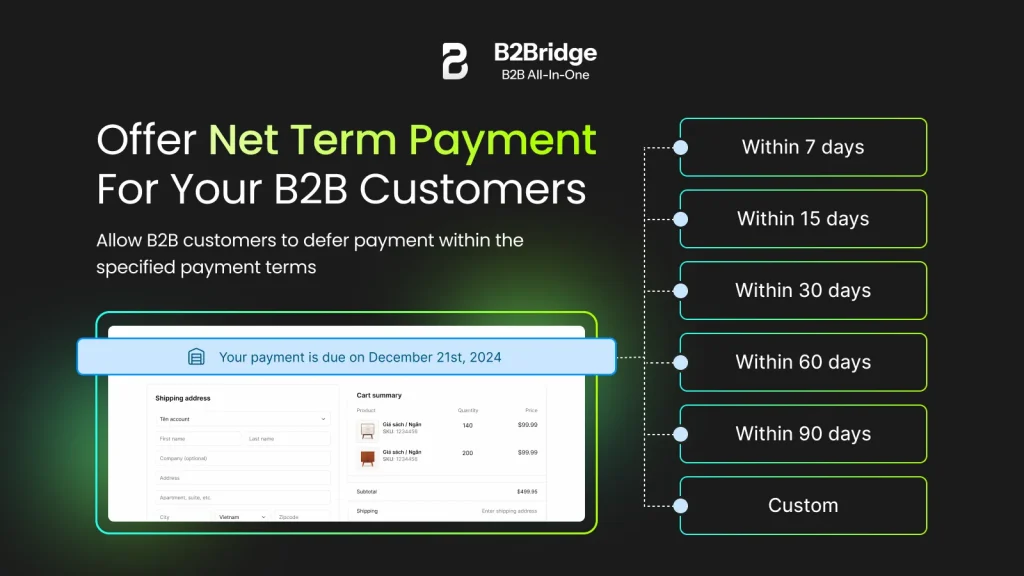
Simplify wholesale management: B2Bridge handles Net 60, Net 30, and custom payment terms automatically – all within your existing Shopify admin.
Protect your pricing strategy: Hide wholesale prices from retail shoppers while showing personalized pricing to approved B2B customers. Support volume discounts, customer-specific pricing, and early payment incentives without complex manual processes.
Scale with confidence: As your wholesale business grows, B2Bridge grows with you. Handle hundreds of B2B customers with different payment terms, and pricing tiers without hiring additional staff or switching platforms.
Save time on operations: Automate registration and approval workflows, assign customers to specific price lists, and process wholesale orders using the same Shopify order management you already know. No more jumping between systems or duplicate data entry.
Offer a seamless buyer experience: Your B2B customers get a smooth, self-serve shopping experience with quick reordering, saved carts, and clear payment term visibility – building loyalty and increasing repeat order rates.
Close more wholesale deals: Built-in quote requests and negotiation tools help you convert prospects into customers. Generate professional quotes, negotiate terms, and convert quotes to orders with one click.
Explore B2Bridge Features | Schedule a Demo | Start Free Trial
Conclusion
Net 60 payment terms represent a powerful tool for B2B businesses seeking to balance competitive positioning with financial health. By giving buyers 60 days to pay, sellers can attract larger customers, strengthen relationships, and grow their wholesale channels – but only when implemented with proper credit management, cash flow planning, and administrative systems.
Ready to take control of your Net 60 payment terms and streamline your wholesale operations? Explore how B2Bridge can transform your B2B channel today.
Hi, I’m Ha My Phan – an ever-curious digital marketer crafting growth strategies for Shopify apps since 2018. I blend language, logic, and user insight to make things convert. Strategy is my second nature. Learning is my habit. And building things that actually work for people? That’s my favorite kind of win.
